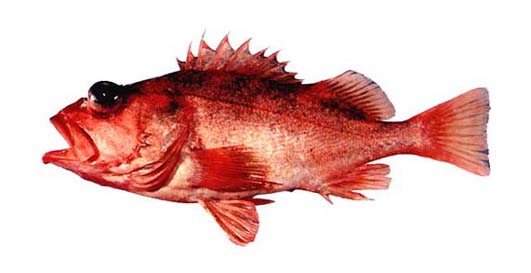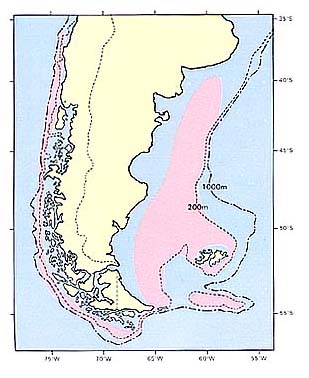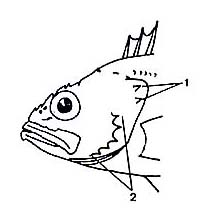フサカサゴ科
- HOME
- デジタル図鑑
- パタゴニア海域の重要水族
- 硬骨魚綱 カサゴ目
- フサカサゴ科
フサカサゴ科(Scorpaenidae)

62 ミナミカサゴ(Minami-kasago)
Sebastes oculatus Cuvier, 1833
Cabarilla (Arg.); Cabarilla, Cabarilla española, Chancharra, Vieja colorada (Ch.); Chamaco (Peru)
特 徴:
背鰭12棘,12~14軟条,臀鰭3棘,6~7軟条,胸鰭17~19軟条,腹鰭1棘,5軟条,鰓耙数7~10+1+19~21=28~32,鰓条骨数7,側線鱗数50~66。頭長は体長の38.7~42.5%,眼径は7.5~9.0%,体高は32.3~37.2%,吻長は10.0~11.5%,両眼間隔は5.8~7.1%,上顎長は19.1~20.6%,尾柄高は9.2~10.5%,胸鰭長は23.8~31.0%,腹鰭長は20.4~22.8%,第1背鰭高は11.9~15.0%,第2背鰭高は12.4~15.9%,臀鰭高は15.4~19.6%。体はむしろ高く,側扁する。頭は大きく,体長は頭長の2.3~2.5倍。吻は中庸で,眼径よりは大きい。眼は大きく,頭長は眼径の4.5~5.0倍。一対の鼻孔があり,前鼻孔は乳頭状皮弁を有す。口は大きく,上顎後端は眼窩後縁下に達する。絨毛状歯帯が両顎,鋤骨,口蓋骨に発達する。上顎先端部に微小な歯からなる一対の小突起がある。鋤骨歯帯はV字型。頭部に鼻棘1,眼前棘1,眼上棘1,眼後棘1,耳棘1,ろ頂骨棘1,上膊棘2,額棘1が発達する。鰓蓋部に主鰓蓋骨棘2と前鰓蓋骨棘5が発達する。擬鰓がある。鰓耙はよく発達する。体部,頭部,鰓蓋部および上顎に小櫛鱗が分布する。背鰭と臀鰭の棘は強く鋭い。胸鰭は大きく,丸味を帯び,外側の8~9鰭条は不分枝で,先端は肛門上に達する。肛門は腹鰭先端と臀鰭起部のほぼ中間に位置する。臀鰭起部は背鰭第2または第3軟条下に位置する。側線は単線で,鰓蓋上縁上から尾部までほぼ直線状に走る。背部に5条の暗色斑が,体側に4~5個の黒点がある。
分 布:
チリ,アルゼンチン パタゴニア。
備 考:
de Buen (1960)は本種をチリで3亜種に分けた:S. o. darwini (Cramer)-北部チリ,S. o. oculatus Cuvier-中部チリ,S. o. chilensis Steindachner-南部チリ。
(中村 泉)
Material examined:
9 from Argentina (205.9-301.8 mm SL), 10 from Chile (179.0-312.2 mm SL), FAKU 43239, AP 762-769; CP 56, 285, 287, 393, 396, 398, 400, 452, 453, 903.
Description:
D ⅩⅡ, 12-14; A Ⅲ, 6-7; P1 17-19; P2 Ⅰ, 5; GR 7-10+1+19-21=28-32; BR 7; LLS 50-66. HL 38.7-42.5% of SL; ED 7.5-9.0; BD 32.3-37.2; SN 10.0-11.5; IO 5.8-7.1; UJ 19.1-20.6; CP 9.2-10.5; P1L 23.8-31.0; P2L 20.4-22.8; D1H 11.9-15.0; D2H 12.4-15.9; A 15.4-19.6.
Body elongate and compressed. Head large, about 2.3-2.5 times in SL. Snout moderate, larger than eye diameter. Eye large, 4.5-5.0 times in HL. Two nostrils, anterior one with pailla. Mouth large, end of maxilla extending to below posterior margin of orbit. Villiform teeth in bands on both jaws, palatines and vomer. A pair of small projections with minute teeth on anterior part of upper jaw. Vomerine tooth band forms V-shape. One nasal spine, 1 preocular spine, 1 supraocular spine, 1 postocular spine, 1 tympanic spine, 1 parietal spine, 2 humeral spines, 5 preopercular spines and 2 opercular spines present. Pseudobranchiae present. Gill-rakers well developed. Small ctenoid scales on body, head, opercle and maxilla. Dorsal and anal spines strong and pungent. Pectoral fin large, round with 8-9 unbranched rays on lower side, its posterior end reaching above anus. Anus situated at midbody between tip of pelvic fin and anal fin origin. Anal fin origin situated below second and third dorsal fin rays. Single lateral line running from upper insertion of opercle to caudal fin base. Five dark blotches on dorsal part of body. Four to five spots on lateral part of body.
Distribution:
Both Chilean and Argentine Patagonia.
Remarks:
Three subspecies, S. o. darwini (Cramer) from northem Chile, S. o. oculatus Cuvier from central Chile and S. o. chilensis Steindachner from southern Chile, were recognized by de Buen (1960).
(Izumi NAKAMURA)

Distribution of Sebastes oculatus in Patagonia.

Head with opercular (1) and preopercular (2) spines.